Excerpts from Jim Conrad's
Naturalist Newsletter
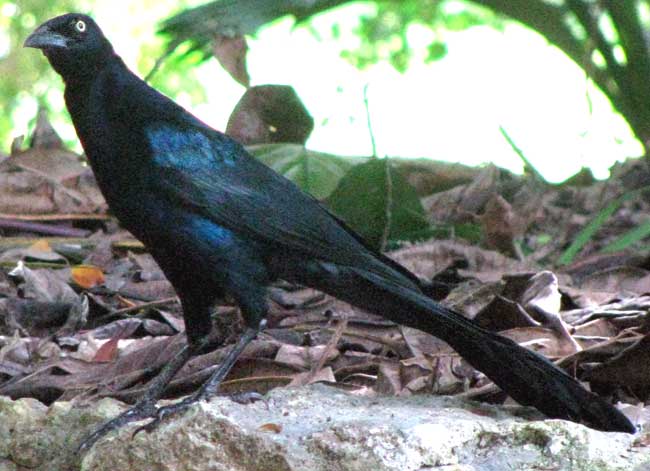
from the December 13, 2009 Newsletter issued from Hacienda Chichen Resort beside Chichén Itzá Ruins, central Yucatán, MÉXICO
GREAT-TAILED GRACKLE
Above you see one of the best known, widely distributed, conspicuous, noisy and gregarious birds Mexico has to offer. It's the Great-tailed Grackle, QUISCALUS MEXICANUS. In some towns you hear them screeching and whistling all the time, but at Hacienda Chichen only a few come and go. I'm guessing that they have a base elsewhere, maybe at the ruins or in Pisté, and during the day fan out to places like this. They're not here every day.
These are fair-sized birds. North America's Common Grackle reaches about 12 inches long (30 cm) while Great-tailed Grackles reach 16 inches (41 cm).
I've always had a soft spot for Great-tailed Grackles because I associate their calls with the feeling of escaping the North's coldness and tension. So many times as I bused south from Kentucky for a winter in Mexico, when I changed buses at dawn in San Antonio I'd step outside the station for fresh air and hear them: Sheer shrieking cacophony in the little park a block away. South of San Antonio I'd hear that sound in every town center I'd pass through all through Mexico. Their calls always said to me "Welcome back to heat, color and rambunctiousness!"
Here's the first part of how Howell describes their calling:
"Varied loud shrieks, clacks, whistles, and chatters, including a bright, piercing, ascending whistle, wheeeeu' or s-weeeeerk!, bright piping to shrieking series in various combinations, wee kee-ee-kee-keek or shreeih dee-dee-dee-dee-dee-dee-dee-dee, etc, a burry note.... " It goes on and on. It's the burbly, unzipped sound and mood of the tropics, exactly there.
My old, 1966 field guide to birds calls them Boat-tailed Grackles, but nowadays that name is reserved for a somewhat smaller species along the US Gulf Coast, which earlier was lumped with our Mexican ones. My 1966 field guide shows Great-tails reaching only into southern and western Texas, and southern Arizona. Since 1966 the species has expanded northward and westward dramatically, now occupying the area shown on eBird.Org's Great-tailed Grackle Range Map.
Part of that enormous expansion may be due to global warming but I suspect that mostly it simply reflects this bird's vigor and aggressiveness, and its ability to exploit certain ecological niches that humans create, like parks with trees, fields and weedy wastelands.
from the February 6, 2012 Newsletter issued from Hacienda Chichen Resort beside Chichén Itzá Ruins, central Yucatán, MÉXICO
GRACKLES CALLING
Last Sunday morning beside the garbage dump just south of Pisté I was a little late to hear the grackle chorus there at full cry, but there was enough to hint at a full-blown grackle cacophony. If your viewer can handle YouTube videos and Javascript, you can hear what I heard by clicking on on the start icon below.
from the December 19, 2010 Newsletter issued from Hacienda Chichen Resort beside Chichén Itzá Ruins, central Yucatán, MÉXICO
GRACKLE BIRDBATH
One advantage to living in a hut with pole walls is that when birds come to your birdbath just outside the door you can photograph them through the spaces between the poles. The hut makes a good photographer's blind.
The other day a small flock of Great-tailed Grackles hung around the Hacienda for two or three days, and they visited, too. Usually grackles don't stay here, preferring towns and ranches, but when they do visit you know they're here because of their screeching, popping, grinding mess of sounds. You can see a female, or maybe an immature, shot between wall poles below:
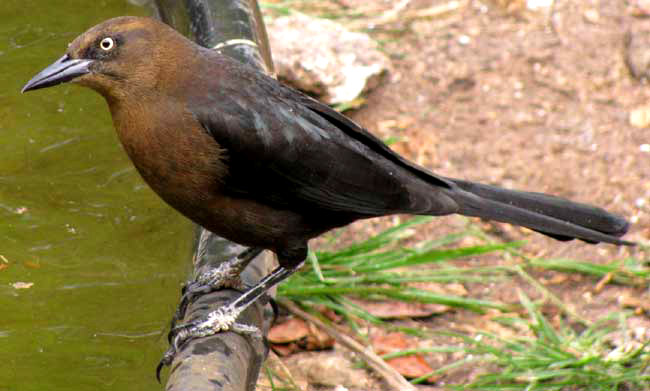
Below, a close-up of the above Great-tailed Grackle not only shows the head's rich, brown feathers contrasting with the much darker plumage farther back, but also what a grackle looks like when drinking water.
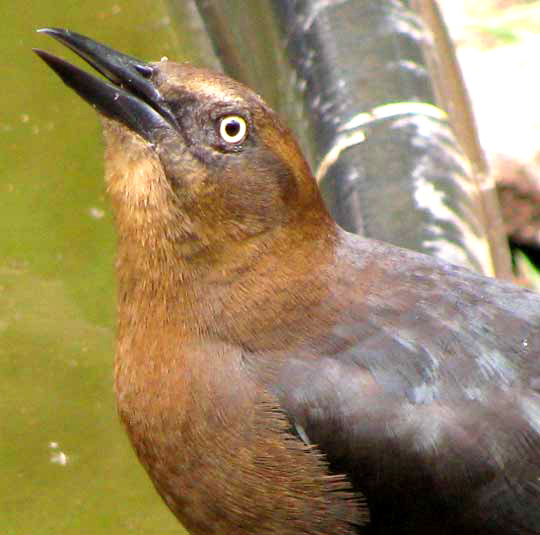
To drink, the bird raises its head, opens its beak, and lets water scooped into the beak trickle by gravity down the throat. This is just how a chicken does it, as well.
In fact, most birds can't swallow by "sucking" or "pumping" water into their esophagi as humans do. Again and again they have to raise their heads and depend on gravity, a method usually described as "sipping" or "tipping up." One group of birds whose members can indeed suck up water is the Pigeon and Dove Order, the Columbiformes.
from the December 27, 2009 Newsletter issued from Hacienda Chichen Resort beside Chichén Itzá Ruins, central Yucatán, MÉXICO
GRACKLE STORY
Adding to my notes of last week about the outrageous sounds Great-tailed Grackles make, Mary in Texas writes that about five years ago she was feeding grackles during the winter months. During that time the birds learned to imitate the "sleazy squeaking sound" her screen door made when she stepped outside with their food. Then she was injured in a car accident and had to stop feeding them. Mary continues:
After not feeding them for 4 days, they all gathered in my back yard and in unison began making that squeaky screen door sound until I found a way to go out and feed them. It was amazing. I've never heard these grackles make that sound in their common lives, but it sounded identical to my back door squeaking. After I fed them, they never made it again!
from the December 4, 2006 Newsletter, note from a visit to Mérida, Yucatán, MÉXICO
GRACKLES IN SAN JUAN PARK
While hiking between bus stations in Mérida, the Yucatan's capital city, I came upon San Juan Park at Calle 69 x 64, saw how pleasant it was, and took an extended rest. It was a small park with maybe ten trees and as many benches, surrounded by busy streets.
In the late afternoon pigeons quietly came and went from the trees, sometimes gliding overhead in flocks of 15-20 birds, their gray and white markings showing handsomely against the trees' dark greens and in the late-afternoon light.
As dusk came on the pigeons left but Great-tailed Grackles started arriving. Most came at that special moment when there's not enough light to show a tree's greenness but there's enough for the top branches and any birds there to show up as satiny silhouettes against the milky sky.
And those treetop silhouettes were constantly in motion. More and more birds were arriving and when they got there they constantly gawked around, called, moved their great tails expressively, and they couldn't stay in any one spot more than a minute or two before they'd change to another branch or fly to another tree. The commotion was tremendous and the grackle-filled trees moved as if the wind were blowing.
One hardly noticed the movement, however, because of the noise. Throughout the day a Great-tailed Grackle is likely to emit every kind of sharply screeching, grating, whistling sound and now the birds were expressing their full repertory, but with their main sound being a single sharp, upward-swinging, second-lasting note. When there was just enough light to see, say, a peanut on the ground, the grackle-noise decibel level was simply hilarious.
Gradually the birds gravitated toward the park's densest trees, the Ficus benjaminas, and it was clear from the mess beneath those trees that every night they were favored with such preference. Denser and denser the grackle population grew in the ficuses, birds on the outside limbs moving into the trees, new birds still arriving on the outer branches.
Though the whole scene was an expression of the birds' powerful coming-together urge, each bird vigorously defended his immediate personal space. If a grackle on a branch was approach too closely by a newcomer, the bird in position lowered his head and opened his beak threateningly. What an interesting conflict -- to want companions near, but not too near, thus always needing to defend an abstract, conjectural and highly debatable boundary. Just like people.
When it was completely dark the grackles grew quiet and I headed to the bus station. During that night of sleeping on the bus I had mixed feelings as I abandoned the Yucatan entirely, with no fixed plans to return.
from the January 24, 2010 Newsletter issued from Hacienda Chichen Resort beside Chichén Itzá Ruins, central Yucatán, MÉXICO
SKY-POINTING GRACKLES
Returning from Pisté with my backpack crammed with oranges and bananas I saw atop a thatched-roof hut three Great-tailed Grackles doing what's shown below:
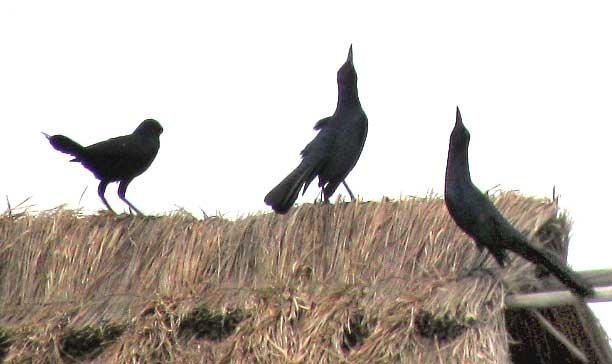
The two birds on the right are males "sky pointing," a behavior also seen among the North's Common Grackles. A webpage on bird behavior describes sky pointing as a display made by a male on the approach of another male, usually resulting in one of the males departing. If I were indulge in anthropomorphic interpretation I'd say that probably in the picture we're seeing a female at the left watching two males determining who will try to claim her.
Another webpage says that sky pointing may have evolved from the birds' drinking posture. Songbirds can't swallow the way humans do so they must fill their beaks, then tilt their heads so that the water runs down their throats.
I can imagine how the drinking posture might have evolved into a ritualized display. Maybe early in grackle evolution females noticed that males who spent the most time at drinking holes were the ones who could defend themselves best from other birds wanting a drink. Thus those who spent the most time with their beaks pointing skyward were also the strongest and quickest. Eventually males learned that if they sky pointed, somehow it attracted the females. Through the millennia sky pointing drifted away from the drinking hole to the multiplicity of places where it's seen today.
You can see how the display might really serve its purpose. I watched the above birds for about five minutes and, though neither bird stopped pointing, the one on the right seemed to lose his concentration from time to time and look around. Even I could see that he wasn't as intensely engaged in the encounter as the other, and a receptive female grackle surely would have detected much more. A lady wants her fellow at least to show some enthusiasm for her.
All this is just guessing, of course. However, as an authentic animal myself with emotions inherited from ancestors that the bird and I at least very distantly hold in common, I claim some license for being able to have at least a glimmer of a notion of what is going on there.
from the June 19, 2016 Newsletter issued from Hacienda Chichen Resort beside Chichén Itzá Ruins; limestone bedrock; elevation ~39m (~128ft), N20.675°, W88.569°; central Yucatán state, MÉXICO
SKY-POINTING GRACKLES #2
Nowadays it's easy to see Great-tailed Grackles "sky pointing," as seen below:
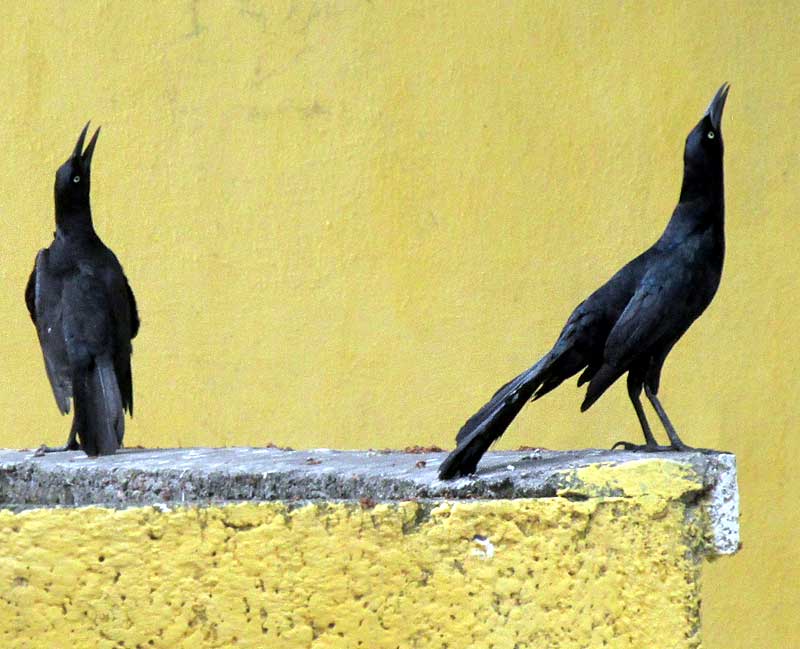
It's always been assumed that sky pointing was some kind of aggressive behavior that somehow helped grackles sort out among themselves who the dominant individuals were.
In 2007, Elissa Wampler and David Gammon published a paper in The Texas Journal of Science, called "Aggressive head-up displays in great-tailed grackles (Quiscalus mexicanus)." After a lot of field observations and the use of statistics, their main finding was that "Males were much more likely than females to use the display, and males were most likely to use the display in groups of mixed sex." They theorized that sky-pointing may help male grackles achieve higher reproductive fitness, but ended by saying that more studies were needed to determine for sure exactly why the birds did it in the first place.
My guess is that, aside from status reasons, sky-pointing helps show which birds are most interested in whatever they seem to be sky-pointing about, whether it's over a food source, a female, or something else. If you watch sky-pointers for awhile, eventually it becomes clear whose mind tends to roam and who is most focused on maintaining his or her assertion, whatever it is. If I were a female grackle over whom two males were sky-pointing, and one of them began glancing at the ground from time to time, I'd begin favoring the male who was interested enough in me to keep sky-pointing.
Sky pointing is a wonderful way of settling disputes, and I think that we humans might do well to try it. For example, instead of going through such long presidential primaries where all kinds of hurtful things are said and done, let the candidates see who can sky-point the longest. Could it be any less effective than the system we have now?
from the August 28, 2011 Newsletter issued from Mayan Beach Garden Inn 20 kms north of Mahahual; Caribbean coastal beach and mangroves, ~N18.89°, ~W87.64°; Quintana Roo state, MÉXICO
PANTING GRACKLE
In mid afternoon when there's little breeze sometimes Great-tailed Grackles quietly rest panting in the shade of palm fronds level with my upstairs porch, as seen below:
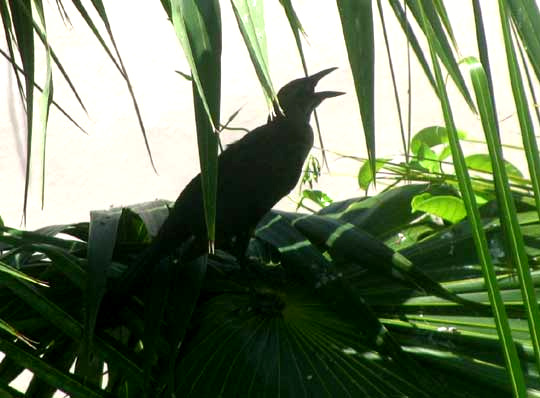
Birds don't sweat, so they keep cool by staying out of the sun when they can, and they pant, letting cooler air carry heat away from their moist lungs. They also flutter their throats, expelling heat from the rich tangle of heat-carrying blood vessels there.
Birds can also raise their feathers and hold their wings out for air circulation, plus they have a few other tricks.